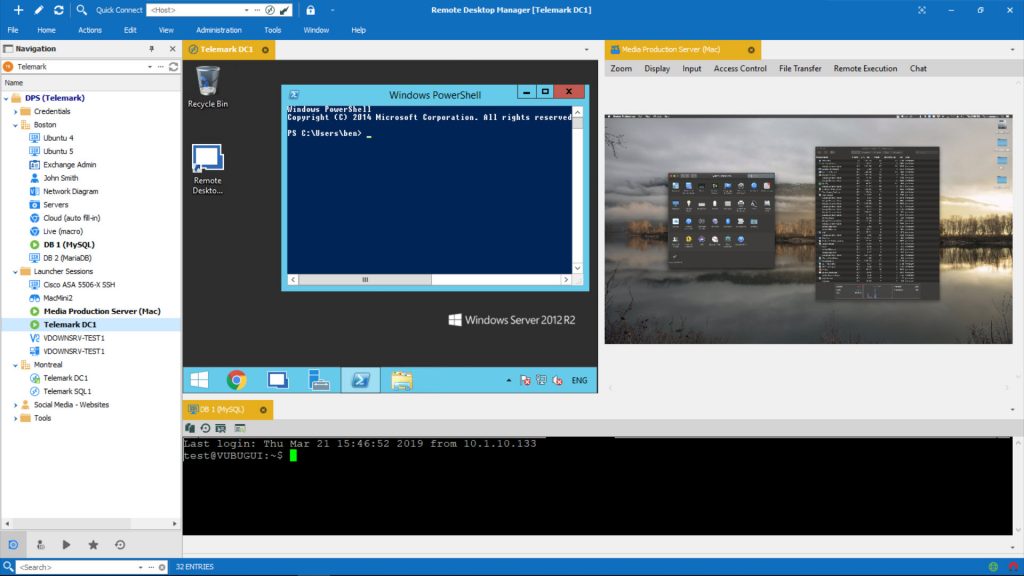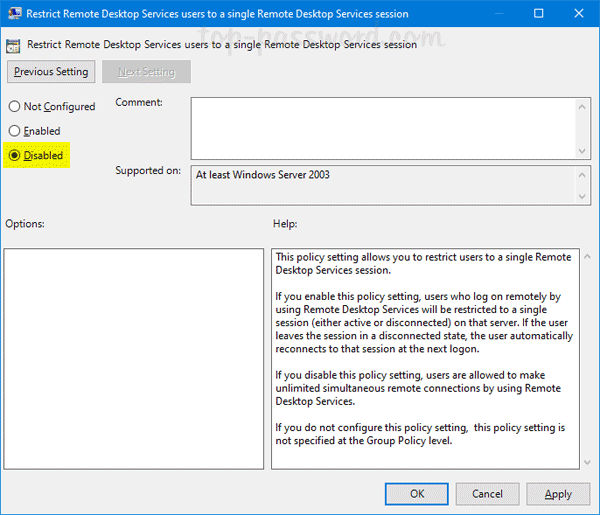Multiple Remote Desktop Connections On Windows Server 2019
The most intuitive way to enable Remote Desktop on Windows is to use a GUI. To enable RDP on a local computer, you need to open the “System” Control Panel item, go to the “Remote Settings” tab and enable the Allow remote connections to this computer option in the Remote Desktop section. However, this requires local access to the computer on which you want to enable RDP. You can usually ask the user for this (local administrator permissions required), or local technical support. However, what to do if no one in the remote branch office could enable the Remote Desktop locally? By default, Remote Desktop is disabled on both desktop versions of Windows and Windows Server.
Enable Multiple RDP Sessions. Log into the server using Remote Desktop.; Open the start screen (press the Windows key) and type gpedit.msc and open it; Go to Computer Configuration Administrative Templates Windows Components Remote Desktop Services Remote Desktop Session Host Connections. Nov 10, 2020 at 13:30 UTC It's more than needing RDS for more than 2 connections. The 2 connections are to administer the server only. For users to connect (or even admins) to do anything else - access data, run programs, whatever, RDS must be licensed - regardless of the number of such users, even if it's only one person.

If you want to remotely enable Remote Desktop (RDP) on a remote host (server or computer), but you don’t have access to the local device console, we’ll show how to do it using PowerShell.
Enable RDP Using Remote Registry Service
You can enable Remote Desktop on a remote computer using Registry Editor. This requires:
- The remote computer must be accessible over the network;
- You must know the credentials of an account with local administrator permissions on the remote computer;
- The Remote Registry service must be running on the remote computer (you can enable it through the services.msc snap-in or GPO).
So, to enable the remote desktop via remote registry, follow these steps:
- Press the Win + R key combination and in the Run window type regedit.exe > Ok;
- In the Registry Editor select File > Connect Network Registry;
- Specify the hostname or IP address of the remote computer.If the remote computer could not authorize you as the current user, you will be prompted to enter credentials;
- The registry of the remote computer will appear in the registry editor (only HKLM and HKEY_Users hives are accessible);
- Go to the following reg key on the remote computer: HKLMSYSTEMCurrentControlSetControlTerminal Server. Change the DWORD value of the fDenyTSConnections parameter from 1 to 0;
- If a firewall is enabled on the remote computer, you must enable the rule that allows remote desktop connections. You can enable it via GPO, via PowerShell Remoting (described in the next section of this guide), or using Psexec. In the latter case, the following commands are used:
- After rebooting, try to connect to the remote computer via RDP.
Enable Remote Desktop Remotely Using PowerShell
To enable RDP remotely, you need to configure and run the WinRM service (Windows Remote Management) on the remote computer. The WinRM service is enabled by default in all versions of Windows Server starting with Windows Server 2012. However, WinRM is disabled by default in client operating systems such as Windows 10. Thus, to enable Remote Desktop remotely via PowerShell, the remote computer must meet the following requirements:
- The WinRM service should be started;
- You must have administrator permissions on the remote device;
- Windows Defender Firewall with Advanced Security must be disabled or the rules that allow remote access through PowerShell Remoting should be enabled.
Suppose you want to remotely enable RDP on Windows Server 2012 R2/2016/ 2019. Open the PowerShell console on your computer and run the following command to connect to your server remotely:
So, you have established a remote session with a computer and now you can execute PowerShell commands on it. To enable Remote Desktop, you just need to change registry parameter fDenyTSConnections from 1 to 0 on the remote computer. Run the command:
When RDP is enabled in this way (as opposed to the GUI method), the rule that allows remote RDP connections is not enabled in the Windows Firewall rules. To allow incoming RDP connections in Windows Firewall, run the command:
Hint. By default, TCP/3389 port is used for incoming Remote Desktop connections on Windows. You can change the default RDP port number through the registry using the PortNumber parameter in the reg key HKEY_LOCAL_MACHINESYSTEMCurrentControlSetControlTerminal ServerWinStationsRDP-Tcp.
If for some reason this firewall rule is missing, you can create it manually:

If you want to restrict hosts or subnets that are allowed to connect to Remote Desktop, you can create a custom rule that allows Windows Firewall to solely accept incoming RDP connections from specific IP addresses, subnets, or IP ranges. In this case, instead of the previous command, you need to use the following one:
If you need to enable secure RDP authentication (NLA – Network Level Authentication), run the command:
Now you can check the availability of TCP port 3389 on the remote host from your computer. Run the command:
There should be a result like this:
ComputerName : 192.168.1.11
RemoteAddress : 192.168.1.11
RemotePort : 3389
InterfaceAlias : Ethernet0
SourceAddress : 192.168.1.90
Windows Server Remote Desktop Service
TcpTestSucceeded : True
This means that RDP on the remote host is enabled and you can establish a remote desktop connection using mstsc.exe, RDCMan, or any alternative RDP client.
Hint. If you need to enable RDP on several remote computers at once, you can use the following PowerShell script:
By default, only members of the local Administrators group can connect via the RDP remotely. To allow RDP connections for non-admin users, just add them to the local Remote Desktop Users group.
READ ALSOHow to Use ForEach Loop in PowerShell?You can add the desired users to the Remote Desktop Users locally by using the Local Users and Groups MMC snap-in (LUSRMGR.MSC).
Or you can change RD Users group membership remotely using the PowerShell Remoting inside the Enter-PSSession. Use the following command to add the domain user ASmith to the local group:
Alternatively, instead of the Enter-PSSession cmdlet, you can use another PS Remoting command Invoke-Command:
How to Enable Remote Desktop over WMI?
If you want to enable RDP on a remote computer where WInRM is disabled (for example, on a regular computer with Windows 10), you can use the WMI PowerShell command.
To check if RDP access is enabled on the remote computer 192.168.1.90, run the command (see the value of the AllowTSConnections property):
To enable RDP and add a Windows Firewall exception rule, run the following command:
Author Recent PostsCyril KardashevskyI enjoy technology and developing websites. Since 2012 I'm running a few of my own websites, and share useful content on gadgets, PC administration and website promotion.Latest posts by Cyril Kardashevsky (see all)
Recent PostsCyril KardashevskyI enjoy technology and developing websites. Since 2012 I'm running a few of my own websites, and share useful content on gadgets, PC administration and website promotion.Latest posts by Cyril Kardashevsky (see all)Usually, RDP server providers give you a single remote desktop connection by default. You won’t have multiple RDP connections, even when you buy admin RDP, which if you log in to the same RDP with a different device, the first session will be lost! But how can we enable multiple concurrent remote desktops? This article will first discover how to activate two RDP sessions and then multiple RDP sessions.
Windows server’s Remote Desktop feature has to be enabled; if it is not and you have not remote access to the server, to do this, use the below link:
Enable Multiple RDP Connections
To have multiple RDP connections, we have to do some configurations. First, we should disable the remote desktop user’s restriction to a single remote user and the second one is to change the limit number of connections.
Steps To Activate Multiple RDP Connections
- Login to your RDP server.
- Press Windows Logo Key (also known as Windows Key) and R key simultaneously to open the Run page.
- Type gpedit.msc and press OK to open Local Group Policy Editor.
- Go to the following path:
Computer Configuration -> Administrative Templates -> windows Component -> Remote Desktop Services -> remote desktop session host -> connections - We need to edit two files here, Edit the Restrict Remote Desktop Services users to a single Remote Desktop Services Session, put the status on Disabled, and then press OK.
Also, edit the Limit number of connections and put the status on Enabled, Increase the RD Maximum Connection allowed to 2.
Note: If you set it more than 2, it won’t make any difference because you can make two concurrent sessions in this case! - It’s done; now you should able to have multiple RDP connections at the same time.
Create New Remote Desktop Users
To administrate RDP sessions, it is better to create separate users. However, you can connect multiple times to RDP with a single user at the same time!

Steps To Create Users
- Open the Computer Management. (Type compmgmt.msc in the Run and press Enter)
- Go to
Computer Management(Local) -> Local User and Groups -> Users, Right-click on Users and select New User…
Note: Also, you should add new users to the Remote Desktop Users Group! - Fill the fields and create as many users as you want(Here you only need 2 users)!
All is set now! try to connect RDP with two different devices and different users.
Let’s take a look at Task Manager to check online users and run on their sessions.
Allow More Than 2 Remote Sessions
To allow more remote users on your Windows server, you need to install the RDS(Remote Desktop Services) and purchase a RDS License, but It will give you 120 days free trial for this feature when you install(without license). Here we will install RDS without ADDC (active directory domain controller).
Steps To Install RDS
- Open Server Manager.
- In Dashboard, select Add roles and features.
- Choose Role-based or feature-based installation in the Installation Type step, and click Next.
- Choose to select a server from the server pool in the Server Selection step and go ahead.
- Tick the Remote Desktop Service check-box in the Server Roles step and click Next.
- Go ahead Features step by default options.
- Tick the Remote Desktop Connection Broker and Remote Desktop Session Host check-boxes, and click Next.Note: Maybe it will ask you to install some pre-required role services or features, which you should accept.Note: If you want to use the RDS deployment beyond the 120-day trial period, you’ll need to install the Remote Desktop Licensing role too.
- In the last step, tick the “Restart the destination server automatically if required” and press Install.Note: It will take a while to be installed completely, and the server may need a few reboots.
That’s it; now you should increase the RD Maximum Connection allowed in the Limit number of connections file (For example 99) and set both files status’ which we described how you could do above already. (Step 2-7 in “Enable Multiple RDP Connections” section)
Conclusion

To have multiple RDP connections, we should disable the single-user remote desktop mode and change the remote connection limit. In this situation, you can have 2 RDP sessions simultaneously for free, but if you wish to have more, you should install the RDS role through the server. This tool is open just for 120 days, and after this period, you will have to buy an RDS license to be able to use it.
I wish you’ve enjoyed this post and found it useful, Feel free to leave a comment.
Remote Desktop To Server
